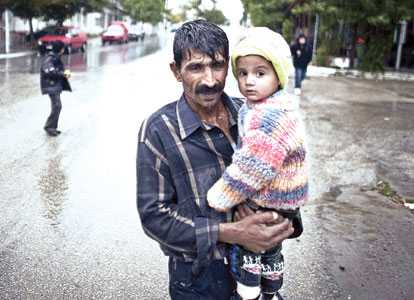FULYA ÖZERKAN
ANKARA – Hürriyet Daily News

The number of asylum-seekers in southern Europe fell by 33 percent last year, driven by significant declines in applications in Italy, Turkey and Greece, a new report released Monday by the International Organization for Migration has revealed.
The World Migration Report 2010 looks into the wave of migration across the globe and calls for the rigorous analysis of core capacities of countries to manage migration effectively and identify gaps and priorities for the future.
In 2009, the total number of asylum-seekers in industrialized nations remained stable with about 377,000 applications, according to the report. The Nordic region recorded a 13 percent increase with 51,100 new applicants – the highest in six years – but by contrast, the number of applications in Southern Europe fell by 33 percent, with 50,100 claims.
That was driven by significant declines in Italy (-42 percent), Turkey (-40 percent) and Greece (-20 percent).
Another fact the comprehensive study revealed was that with the exception of Germany, most Western and Central European countries experienced an increase in their populations. For the majority of these countries, the increase was due to both positive natural population change (a higher number of live births than deaths during the year) and positive net migration (a higher number of immigrants than emigrants).
In Turkey, along with Macedonia and Poland, the number of emigrants is larger than the number of immigrants but a higher birth rate than death rate keeps the total population growing, said the report.
Turkey’s Prime Minister Recep Tayyip Erdoğan has repeatedly suggested that each family in Turkey should have at least three children to overcome the adverse effects of the gradual decrease that will occur in the country’s growth rate over the next 30 years. His remarks, when first uttered, sparked heavy debates in academic circles, with many arguing that encouraging people to have more children is not a solution for an aging population.
The report also looks into changes in the populations of internally displaced persons, or IDPs. Despite an important 1.1-million-person drop in the IDP population in Sudan, it remains the most affected country, with 4.9 million IDPs. There has also been a slight drop in the IDP population in Iraq – from 2,778,000 to 2,764,111. But the report reveals this too remains high given Iraq has the third-largest IDP population in the world as of 2010. Colombia stands as the second largest with 3.3 million.
Other previously important IDP populations, however, have remained largely unchanged according to the research. This is the case in Turkey as well as in Azerbaijan, Kenya, Nepal, Peru, Senegal and, despite their upheavals, in Georgia and Sri Lanka. In Georgia, it seems that most of the displaced (apart from ethnic Georgians displaced from Abkhazia and South Ossetia) have returned to their homes.
Regarding overall immigration policy of countries, the report notes that responses to current and emerging migration challenges and opportunities are often short-term, piecemeal and fragmented although hundreds of millions of dollars are spent each year by the states to manage migration.
If the number of international migrants, estimated at 214 million in 2010, continues to grow at the same pace as during the last 20 years, it could reach 405 million by 2050, it warned.
One of the reasons for this steep rise will be significant growth in the labor force in developing countries, from 2.4 billion in 2005 to 3.6 billion in 2040, accentuating the global mismatch between labor supply and demand. The impact of environmental change will also affect migration trends in the future.